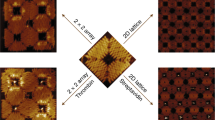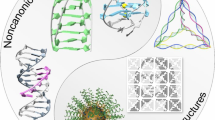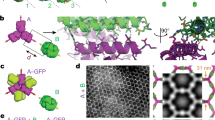Abstract
An important goal of nanotechnology is to assemble multiple molecules while controlling the spacing between them. Of particular interest is the phenomenon of multivalency, which is characterized by simultaneous binding of multiple ligands on one biological entity to multiple receptors on another1. Various approaches have been developed to engineer multivalency by linking multiple ligands together2,3,4. However, the effects of well-controlled inter-ligand distances on multivalency are less well understood. Recent progress in self-assembling DNA nanostructures with spatial and sequence addressability5,6,7,8,9,10,11,12 has made deterministic positioning of different molecular species possible8,11,12,13. Here we show that distance-dependent multivalent binding effects can be systematically investigated by incorporating multiple-affinity ligands into DNA nanostructures with precise nanometre spatial control. Using atomic force microscopy, we demonstrate direct visualization of high-affinity bivalent ligands being used as pincers to capture and display protein molecules on a nanoarray. These results illustrate the potential of using designer DNA nanoscaffolds to engineer more complex and interactive biomolecular networks.
This is a preview of subscription content, access via your institution
Access options
Subscribe to this journal
Receive 12 print issues and online access
$259.00 per year
only $21.58 per issue
Buy this article
- Purchase on Springer Link
- Instant access to full article PDF
Prices may be subject to local taxes which are calculated during checkout



Similar content being viewed by others
References
Mammen, M., Choi, S. K. & Whitesides, G. M. Polyvalent interactions in biological systems: implications for design and use of multivalent ligands and inhibitors. Angew. Chem. Int. Ed. 37, 2755–2794 (1998).
Di Giusto, D. A. & King, G. C. Construction, stability, and activity of multivalent circular anticoagulant aptamers. J. Biol. Chem. 279, 46483–46489 (2004).
Fredriksson, S. et al. Protein detection using proximity-dependent DNA ligation assays. Nat. Biotechnol. 20, 473–477 (2002).
Pei, R. et al. Behaviour of polycatalytic assemblies in a substrate-displaying matrix. J. Am. Chem. Soc. 128, 12693–12699 (2006).
Rothemund, P. W. K., Papadakis, N. & Winfree, E. Algorithmic self-assembly of DNA sierpinski triangles. PloS. Biol. 2, 2041–2053 (2004).
Lund, K., Liu, Y., Lindsay, S. & Yan, H. Self-assembling a molecular pegboard. J. Am. Chem. Soc. 127, 17606–17607 (2005).
Liu, Y., Ke, Y. G. & Yan, H. Self-assembly of symmetric finite-size DNA nanoarrays. J. Am. Chem. Soc. 127, 17140–17141 (2005).
Park, S. H. et al. Finite-size, fully addressable DNA tile lattices formed by hierarchical assembly procedures. Angew. Chem. Int. Ed. 45, 735–739 (2006).
Rothemund, P. W. K. Folding DNA to create nanoscale shapes and patterns. Nature 440, 297–302 (2006).
Pistol, C. & Dwyer, C. Scalable, low-cost, hierarchical assembly of programmable DNA nanostructures. Nanotechnology 18, 125305 (2007).
Chhabra, R. et al. Spatially addressable multiprotein nanoarrays templated by aptamer-tagged DNA nanoarchitectures. J. Am. Chem. Soc. 129, 10304–10305 (2007).
Ke, Y., Lindsay, S., Yung, C., Liu, Y. & Yan, H. Self-assembled water soluble nucleic acid probe tiles for label-free RNA hybridization assays. Science 319, 180–183 (2008).
Zheng, J. W. et al. Two-dimensional nanoparticle arrays show the organizational power of robust DNA motifs. Nano Lett. 6, 1502–1504 (2006).
Nimjee, S. M., Rusconi, C. P. & Sullenger, B. A. Aptamers: an emerging class of therapeutics. Annu. Rev. Med. 56, 555–583 (2005).
Tasset, D. M., Kubik, M. F. & Steiner, W. Oligonucleotide inhibitors of human thrombin that bind distinct epitopes. J. Mol. Biol. 272, 688–698 (1997).
Bock, L. C., Griffin, L. C., Latham, J. A., Vermaas, E. H. & Toole, J. J. Selection of single-stranded-DNA molecules that bind and inhibit human thrombin. Nature 355, 564–566 (1992).
Padmanabhan, K., Padmanabhan, K. P., Ferrara, J. D., Sadler, J. E. & Tulinsky, A. The structure of alpha-thrombin inhibited by a 15-mer single-stranded-DNA aptamer. J. Biol. Chem. 268, 17651–17654 (1993).
Stubbs, M. T. & Bode, W. The clot thickens: clues provided by thrombin structure. Trends Biochem. Sci. 20, 23–28 (1995).
Ke, Y., Liu, Y., Zhang, J. & Yan, H. A study of DNA tube formation mechanisms using 4-, 8-, and 12-helix DNA nanostructures. J. Am. Chem. Soc. 128, 4414–4421 (2006).
Li, J., Fang, X. & Tan, W. Molecular aptamer beacons for real-time protein recognition. Biochem. Biophys. Res. Comm. 292, 31–40 (2002).
Liu, Y., Lin, C., Li, H. & Yan, H. Aptamer-directed self-assembly of protein arrays on a DNA nanostructure. Angew. Chem. Int. Ed. 44, 4333–4338 (2005).
Williams, B. A. R., Lund, K., Liu, Y., Yan, H. & Chaput, J. C. Self-assembled peptide nanoarrays: an approach to studying protein–protein interactions. Angew. Chem. Int. Ed. 46, 3051–3054 (2007).
Tumpane, J. et al. Triplex addressability as a basis for functional DNA nanostructures. Nano Lett. 7, 3832–3839 (2007).
Acknowledgements
This work was derived from a discussion of the synthetic antibody project with S.A. Johnston at the Biodesign Institute, Arizona State University. We also thank S. Lindsay, C. Diehnelt and Dong-Kyun Seo for helpful discussions. S.R. was partly supported by the Technology and Research Initiative Fund from Arizona State University to S.A. Johnston. This work was partly supported by grants from the National Science Foundation, the National Institute of Health, the Air Force Office of Scientific Research and the Office of Naval Research to Hao Yan and TRIF funds from Arizona State University to Hao Yan and Yan Liu.
Author information
Authors and Affiliations
Contributions
H.Y. and Y.L conceived the project. H.Y., Y.L, S.R. and Y.K. designed the experiments. S.R., Y.K. and R.C. performed the experiments. H.Y., Y.L., S.R. and Y.K. analysed the data. H.Y., Y.L. and S.R. co-wrote the paper. All authors discussed the results and commented on the manuscript.
Corresponding authors
Supplementary information
Rights and permissions
About this article
Cite this article
Rinker, S., Ke, Y., Liu, Y. et al. Self-assembled DNA nanostructures for distance-dependent multivalent ligand–protein binding. Nature Nanotech 3, 418–422 (2008). https://doi.org/10.1038/nnano.2008.164
Received:
Accepted:
Published:
Issue Date:
DOI: https://doi.org/10.1038/nnano.2008.164
This article is cited by
-
Assembly of peptide nanostructures with controllable sizes
Nano Research (2024)
-
Research progress of multi-enzyme complexes based on the design of scaffold protein
Bioresources and Bioprocessing (2023)
-
DNA origami
Nature Reviews Methods Primers (2021)
-
A DNA origami-based aptamer nanoarray for potent and reversible anticoagulation in hemodialysis
Nature Communications (2021)
-
Nucleic Acids Analysis
Science China Chemistry (2021)



